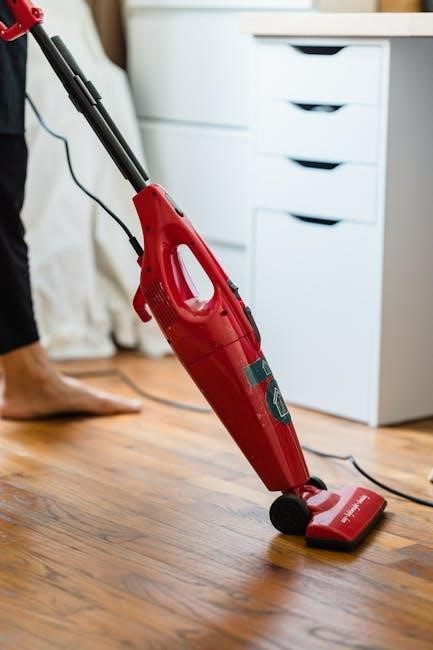Welcome to the USI Electric Smoke Detector Manual‚ your guide to understanding and installing smoke detection systems for enhanced home safety‚ featuring key features and maintenance tips.
1.1 Overview of USI Electric Smoke Detectors
USI Electric Smoke Detectors are advanced safety devices designed to provide reliable fire protection for residential and commercial spaces. Known for their durability and accuracy‚ these detectors utilize ionization‚ photoelectric‚ or universal smoke-sensing technologies to detect fires early. Models like the USI-1204 and USI-5304 offer hardwired and battery-powered options‚ ensuring continuous monitoring. They feature interconnectivity‚ allowing multiple units to sound alarms simultaneously‚ enhancing safety. With UL certification and compliance with local fire codes‚ these detectors meet high safety standards. Their compact design and easy installation make them a popular choice for homeowners and professionals alike‚ ensuring peace of mind through effective fire detection and alerts.
1.2 Importance of Reading the Manual
Reading the USI Electric Smoke Detector Manual is essential for ensuring proper installation‚ operation‚ and maintenance of your smoke detection system. The manual provides critical information on understanding alarm types‚ troubleshooting common issues‚ and adhering to safety standards. It also guides you through interconnecting multiple detectors‚ which is vital for whole-home protection. By following the manual‚ you can avoid potential hazards and ensure your smoke detectors function optimally. Proper installation and maintenance procedures outlined in the manual help prevent false alarms and ensure timely alerts in case of emergencies. Compliance with local fire codes and UL certifications is also explained‚ ensuring your system meets all safety requirements.
1.3 Key Features of USI Electric Smoke Detectors
USI Electric Smoke Detectors are designed with advanced features to ensure reliable fire detection and safety. Models like the USI-1204 and USI-5304 offer hardwired ionization technology for accurate smoke sensing. They support universal smoke sensing‚ combining ionization and photoelectric detection for comprehensive coverage. These detectors can interconnect with up to 11 other units‚ providing whole-home protection. A silence control function allows users to temporarily mute false alarms. Additionally‚ they meet UL certification standards‚ ensuring compliance with safety regulations. Some models also feature combination smoke and carbon monoxide detection‚ offering dual protection. Proper installation‚ as outlined in the manual‚ is crucial to maximize these features and ensure optimal performance in emergency situations.

Understanding USI Electric Smoke Detector Models
USI Electric Smoke Detectors offer a range of models‚ including the USI-1204 and USI-5304‚ designed for reliable fire detection with advanced features like ionization technology and interconnectivity.
2.1 USI-1204 Model Specifications
The USI-1204 is a hardwired ionization smoke detector designed for both residential and commercial use. It features a 120V AC power source with a 9V battery backup for continuous operation during power outages. This model includes a silence control function‚ allowing users to temporarily mute false alarms. The USI-1204 can interconnect with up to 11 other compatible smoke alarms‚ ensuring a unified response in case of an emergency. Its compact design and easy installation make it a popular choice for homeowners. The detector also meets UL 217 standards‚ ensuring reliability and compliance with safety regulations. Regular maintenance is recommended to maintain optimal performance.
2.2 USI-5304 Model Features
The USI-5304 is a state-of-the-art smoke detector offering advanced features for reliable fire protection. It operates on a 120V AC power supply with a 9V battery backup‚ ensuring uninterrupted monitoring. This model utilizes universal smoke sensing technology‚ combining ionization and photoelectric detection for accurate alarm triggering. The USI-5304 features a smart interconnectivity option‚ allowing it to link with up to 24 devices‚ including smoke and carbon monoxide detectors. It also includes a silence control function to mute false alarms and a low-battery indicator for timely replacements. Designed for durability‚ the USI-5304 meets UL standards and is suitable for various installations‚ making it a versatile choice for homes and businesses. Its user-friendly design ensures easy setup and maintenance.
2.3 USI Electric Combination Smoke and Carbon Monoxide Detectors
USI Electric offers combination smoke and carbon monoxide detectors that provide dual protection against fire and CO hazards. These detectors are designed to detect both smoke and carbon monoxide‚ ensuring early warnings for both threats. They feature advanced sensors that minimize false alarms and provide clear alerts through a loud siren. Some models are hardwired with battery backup‚ ensuring continuous operation during power outages. The combination detectors are UL-certified and comply with local safety regulations. They can be interconnected with other USI Electric devices‚ creating a comprehensive safety network. These detectors are ideal for homes‚ apartments‚ and commercial spaces‚ offering peace of mind with their reliable performance and user-friendly design.

Installation Guidelines
Ensure proper installation of USI Electric Smoke Detectors by following manual instructions‚ including hardwiring‚ battery placement‚ and interconnectivity setup to meet local fire safety codes effectively.
3.1 Pre-Installation Requirements
Before installing your USI Electric Smoke Detector‚ ensure you have a suitable location following local fire codes. Verify the power supply requirements‚ either hardwired or battery-operated‚ and ensure all necessary tools and materials are available. Review the manual thoroughly to understand compatibility with existing systems. Check for any environmental factors that may affect performance‚ such as humidity or extreme temperatures. Ensure the device is UL-certified and meets all safety standards. Plan the layout to cover all sleeping areas and critical spaces. Finally‚ disconnect power before starting any installation to avoid electrical hazards.
3.2 Step-by-Step Installation Process
Begin by mounting the bracket on the ceiling or wall‚ ensuring it is level and secure. For hardwired models‚ connect the wires to the terminal screws‚ following the manual’s wiring diagram. Insert the battery for battery-operated detectors‚ ensuring it is properly seated. Attach the smoke detector to the bracket by twisting it clockwise until it clicks. Test the alarm by pressing the test button to ensure it sounds correctly. For interconnectable models‚ connect the wires between detectors to synchronize alerts. Refer to the manual for specific instructions‚ especially for hardwired systems‚ which may require professional assistance. Finally‚ clean the area around the detector to prevent dust interference and ensure optimal performance.
3.3 Recommended Locations for Smoke Detectors
Install smoke detectors in strategic locations to maximize fire detection and safety. Place one inside or outside every bedroom‚ ensuring coverage of escape routes. Additionally‚ install detectors in hallways leading to bedrooms and on every level of the home‚ including the basement. For optimal coverage‚ position detectors at least 10 feet away from cooking appliances to minimize false alarms. Avoid areas near windows‚ doors‚ or ducts where drafts may interfere with sensor accuracy. Ensure detectors are mounted on ceilings or walls‚ following the manufacturer’s height guidelines. Proper placement ensures early detection‚ providing critical time to evacuate during an emergency.

Operating the USI Electric Smoke Detector
Understand your detector’s operation‚ including power sources‚ alarm types‚ and interconnectivity. Hardwired models require AC power‚ while some include battery backup. Ionization‚ photoelectric‚ or universal alarms are available‚ and multiple detectors can interconnect for whole-house protection.
4.1 Powering the Detector
The USI Electric Smoke Detector is typically hardwired‚ requiring a 120V AC power supply. Some models include a 9-volt battery backup to ensure operation during power outages. To activate the battery‚ remove the pull-tab and discard it. Ensure the AC connector is securely plugged into the alarm base. For battery-only models‚ install a fresh 9-volt battery as specified. Always verify that the detector is powered on by checking the LED indicator‚ which flashes periodically to confirm proper function. Regularly test the alarm to ensure it is operational. Proper power installation is crucial for reliable performance and safety. Refer to the manual for specific wiring instructions and battery maintenance tips.
4.2 Understanding Alarm Types (Ionization‚ Photoelectric‚ Universal)
USI Electric Smoke Detectors feature three primary alarm types: Ionization‚ Photoelectric‚ and Universal. Ionization detectors are highly sensitive to fast-flaming fires‚ while Photoelectric detectors excel at detecting smoldering fires. Universal alarms combine both technologies for comprehensive protection. Understanding these types ensures proper placement and functionality. Ionization alarms are ideal for kitchens and living areas‚ whereas Photoelectric detectors are better suited for bedrooms and hallways. Universal alarms offer the best of both worlds‚ providing reliable detection for various fire scenarios. Always choose the right type based on your home’s needs to maximize safety and compliance with fire protection standards.
4.3 Interconnecting Multiple Detectors
Interconnecting multiple USI Electric Smoke Detectors ensures a unified response during emergencies. Up to 11 detectors can be linked‚ enabling all alarms to sound when one detects smoke. This feature enhances safety by providing early warning throughout the home. The system supports both hardwired and wireless connections‚ offering flexibility for different setups. For hardwired systems‚ ensure all detectors are compatible and properly connected to the same circuit. Wireless interconnectivity eliminates the need for wiring‚ simplifying installation. Always follow the manual’s guidelines for interconnection to maintain reliability and compliance with safety standards. Proper interconnection ensures seamless communication between detectors‚ maximizing protection for you and your family.

Maintenance and Troubleshooting
Regular maintenance ensures optimal performance. Clean detectors monthly with a vacuum to remove dust. Test alarms weekly and replace batteries annually. Address issues promptly to avoid false alarms.
5.1 Regular Maintenance Tips
Performing routine maintenance ensures your USI Electric Smoke Detector operates efficiently. Begin by vacuuming the detector monthly to remove dust and debris‚ which can interfere with sensor accuracy. Test the alarm weekly by pressing the test button to confirm it emits a clear‚ loud signal. Replace batteries annually‚ or as indicated by a low-battery chirp. For hardwired models‚ check connections to ensure they are secure. Never paint the detector‚ as this can block sensors. Additionally‚ inspect the unit for physical damage or wear. Replace the detector every ten years or as specified by the manufacturer to maintain reliability and safety.
5.2 Common Issues and Solutions
Common issues with USI Electric Smoke Detectors include false alarms‚ low-battery chirps‚ and sensor malfunctions. For false alarms‚ check for dust or cooking fumes and clean the detector; If the issue persists‚ consider relocating it. A low-battery chirp indicates the need for replacement; swap the battery with the recommended type. For sensor issues‚ ensure no obstructions block the sensing chamber. Interconnectivity problems can occur if detectors are not compatible or wired correctly; verify connections and compatibility. If alarms sound without cause‚ reset the system by disconnecting power and reconnecting. Always refer to the manual for specific troubleshooting steps‚ and replace detectors every 10 years for optimal performance.
5.3 Resetting the Alarm
To reset a USI Electric Smoke Detector‚ first‚ ensure the alarm is not triggered by smoke or CO. For hardwired models‚ turn off the power at the circuit breaker and wait 10 seconds before restoring power. This will reset the system. For battery-operated detectors‚ remove the battery‚ press and hold the test button for 10 seconds to discharge any residual power‚ then reinstall the battery. If interconnected‚ resetting one detector will reset all. If the alarm continues‚ check for obstructions or clean the sensor. Always refer to the manual for specific reset procedures‚ as methods may vary by model. Regular resets ensure proper functioning and reduce false alarms.

Safety Standards and Compliance
USI Electric Smoke Detectors meet UL standards and comply with local fire codes‚ ensuring safety and reliability for home and property protection.
6.1 UL (Underwriters Laboratories) Certification
USI Electric Smoke Detectors are UL-certified‚ meeting rigorous safety standards for smoke and carbon monoxide detection. The UL 217 standard ensures reliable smoke detection‚ while UL 2034 covers carbon monoxide safety. These certifications guarantee the detectors’ performance under various conditions‚ providing users with enhanced safety and peace of mind. UL certification is a mark of trust‚ verifying that the products have undergone extensive testing for reliability and effectiveness. Compliance with these standards ensures the detectors function optimally‚ protecting lives and property from fire and CO hazards. Always look for the UL mark when selecting smoke detectors to ensure they meet the highest safety requirements.
6.2 Compliance with Local Fire Codes
USI Electric Smoke Detectors are designed to comply with local fire codes‚ ensuring they meet specific safety requirements in different jurisdictions. Fire codes vary by region‚ and proper installation of USI detectors helps satisfy these regulations. Compliance ensures the detectors are installed correctly‚ with appropriate placement and interconnected systems as mandated by local laws. Adhering to fire codes not only enhances safety but also avoids legal issues. Always verify local fire codes before installation to ensure full compliance. USI detectors are adaptable to various code requirements‚ making them a reliable choice for fire safety in both residential and commercial settings. Proper installation and maintenance are key to meeting these standards effectively.
6.3 Environmental and Safety Regulations
USI Electric Smoke Detectors are designed to meet rigorous environmental and safety regulations‚ ensuring they are eco-friendly and safe for use in various settings. These detectors comply with global standards for reducing environmental impact‚ such as energy efficiency and recyclable materials. They also adhere to safety regulations‚ including resistance to extreme temperatures and humidity. USI detectors undergo rigorous testing to ensure they perform reliably in diverse conditions while minimizing environmental footprint. Compliance with these regulations ensures that the detectors are both safe and sustainable‚ making them a responsible choice for home and commercial safety systems. This commitment to environmental and safety standards underscores USI’s dedication to producing high-quality‚ reliable smoke detection products.

User Guides and Manuals
The USI Electric Smoke Detector Manual provides comprehensive guidance on installation‚ operation‚ and maintenance. Accessible online or via product packaging‚ it ensures safe and effective use of the device.
7.1 Accessing the USI Electric Smoke Detector Manual
To access the USI Electric Smoke Detector Manual‚ visit the official Universal Security Instruments website. Click on the “Support” section‚ then select “Product Manuals.” Enter your smoke detector model number‚ such as USI-1204 or USI-5304‚ and download the PDF; Additionally‚ manuals are included in the product packaging at purchase. For hardwired models‚ ensure you refer to the specific guide for your device. Online resources also offer troubleshooting guides and installation instructions‚ providing comprehensive support for optimal smoke detector functionality and compliance with safety standards.
7.2 Understanding the Manual’s Content
The USI Electric Smoke Detector Manual provides detailed instructions for installation‚ operation‚ and maintenance. It covers key features of models like the USI-1204 and USI-5304‚ including ionization‚ photoelectric‚ and universal smoke sensing technologies. The manual outlines step-by-step installation processes‚ recommended locations for detectors‚ and troubleshooting tips. Additionally‚ it explains how to interconnect multiple detectors and reset alarms. Compliance with safety standards like UL certification is emphasized. Diagrams and charts are included to simplify complex procedures. For advanced users‚ the manual also discusses smart interconnectivity and battery management. By following the guide‚ users can ensure their smoke detectors function optimally‚ providing reliable fire safety protection for their homes or businesses. Regular updates are available online for the latest safety protocols.
7.3 Troubleshooting Guide
This section helps resolve common issues with your USI Electric Smoke Detector. If the alarm chirps‚ check for low battery or expired life. For false alarms‚ clean the detector to remove dust or debris. If interconnected detectors malfunction‚ ensure all units are powered and properly connected. Reset the alarm by pressing the test/silence button or disconnecting power temporarily. For persistent issues‚ refer to the manual or contact customer support. Regularly test detectors and replace batteries every 6-12 months. Addressing these problems ensures reliable performance and home safety. Always follow safety guidelines when troubleshooting electrical devices.

Advanced Features of USI Electric Smoke Detectors
USI Electric Smoke Detectors offer smart interconnectivity‚ enabling a network of alarms to sound simultaneously. The silence control function allows temporary muting of non-critical alarms. Enhanced battery management ensures reliable performance and longevity‚ while universal smoke sensing technology improves detection accuracy. These features provide comprehensive home safety and convenience.
8.1 Smart Interconnectivity
USI Electric Smoke Detectors feature advanced smart interconnectivity‚ allowing multiple alarms to be linked together. This creates a network where if one detector senses smoke‚ all connected alarms will sound. This ensures comprehensive coverage and quick notification throughout the home. The system supports up to 24 interconnected devices‚ including smoke‚ carbon monoxide‚ and heat detectors. The maximum distance between the first and last device in the network is 1‚000 feet‚ ensuring reliable communication. This feature complies with safety standards and enhances overall home protection by providing a unified response to potential threats. Smart interconnectivity is a key advantage‚ offering seamless integration and enhanced safety for residents.
8.2 Silence Control Function
The USI Electric Smoke Detector features a convenient Silence Control Function‚ allowing users to temporarily mute the alarm during non-emergency situations‚ such as cooking fumes. This feature is activated by pressing a button on the detector or remote control. The silence function ensures the alarm is not permanently disabled‚ maintaining safety compliance. It is designed to be user-friendly while adhering to safety standards. The manual provides clear instructions on how to use this function without compromising the device’s effectiveness. This feature enhances user experience by reducing nuisance alarms while ensuring continuous protection. Proper usage is essential to avoid false sense of security.
8.3 Battery and Power Management
The USI Electric Smoke Detector offers efficient battery and power management to ensure continuous protection. For battery-powered models‚ a low-battery chirp signals when replacement is needed. Hardwired units have a battery backup for reliability during power outages. The manual provides guidelines for installing and replacing batteries‚ emphasizing the importance of using compatible types. Proper battery maintenance is crucial for optimal performance and safety. Users should avoid mixing old and new batteries to prevent malfunction. Regularly testing the alarm after battery replacement ensures functionality. This feature ensures uninterrupted monitoring‚ providing peace of mind for homeowners. Adhering to these guidelines helps maintain the detector’s effectiveness and longevity.

FAQs About USI Electric Smoke Detectors
Frequently Asked Questions address common concerns‚ such as battery replacement‚ alarm chirping‚ and painting‚ providing clear solutions to ensure proper functionality and user understanding of the devices.
9.1 How to Replace the Battery

To replace the battery in your USI Electric Smoke Detector‚ first ensure the device is turned off or disconnected from power. Open the detector by gently pulling it away from the mounting bracket or twisting it counterclockwise. Locate the battery compartment‚ usually found on the back or side of the unit. Remove the old battery and discard it properly. Insert a new 9-volt battery‚ ensuring the terminals align correctly. Replace the compartment cover and reattach the detector to its mounting bracket. Test the alarm by pressing the test button to confirm it works. Always use high-quality batteries for optimal performance and safety.
9.2 Why Does the Alarm Chirp?
The USI Electric Smoke Detector may chirp due to a low battery‚ signaling the need for replacement. Other causes include dust or debris in the sensor‚ which can trigger false alarms. Interconnected systems may also chirp if there’s an issue with one of the linked detectors. To resolve this‚ first‚ check and replace the battery. If the problem persists‚ clean the detector using a soft brush or vacuum to remove any obstructions. Ensure all interconnected units are functioning correctly. If chirping continues‚ refer to the manual or contact customer support for further assistance. Regular maintenance can help prevent such issues and ensure reliable performance.
9.3 Can I Paint the Smoke Detector?
It is generally not recommended to paint the USI Electric Smoke Detector‚ as this can interfere with its sensor functionality and reduce its effectiveness in detecting smoke. Paint may block the sensor openings or damage the internal components‚ leading to false alarms or failure to detect hazards. If you wish to customize the color of the detector‚ contact USI directly to inquire about factory-painted options or alternative models that match your desired aesthetic; Always follow the manufacturer’s guidelines to ensure the detector operates correctly and maintains its safety certifications. Painting the device may void its warranty or compromise its performance.
USI Electric Smoke Detectors provide reliable safety solutions. Ensure proper installation‚ maintenance‚ and testing for optimal performance. Regular checks and adherence to manual guidelines are essential for safety.
10.1 Summary of Key Points
The USI Electric Smoke Detector Manual provides essential guidance for installation‚ operation‚ and maintenance of smoke detection systems. Key features include advanced sensor technology‚ interconnectivity‚ and silence control. Proper installation in recommended locations ensures optimal performance. Regular maintenance‚ such as cleaning and battery replacement‚ is crucial for reliability. Compliance with safety standards like UL certification guarantees adherence to industry benchmarks. Understanding alarm types and troubleshooting common issues enhances user confidence. By following the manual’s instructions‚ users can ensure their smoke detectors function effectively‚ providing critical early warnings in emergencies. Consistent adherence to these guidelines maximizes safety and prolongs the lifespan of the device.
10.2 Final Tips for Optimal Performance
To ensure your USI Electric Smoke Detector operates at its best‚ test alarms monthly and replace batteries annually. Clean detectors regularly to avoid dust buildup. Install smoke alarms in recommended locations‚ such as near bedrooms and living areas‚ to maximize coverage; Interconnect multiple detectors for whole-home protection. Always follow the manual’s troubleshooting guide for resolving issues promptly. Replace the detector every 10 years or as specified. Ensure compliance with local fire codes and UL standards for reliability. By adhering to these tips‚ you can trust your smoke detector to provide consistent‚ reliable protection for your home and family.



Be the first to reply